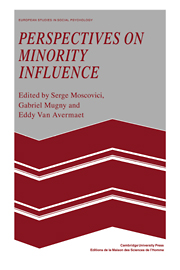Book contents
- Frontmatter
- Contents
- Contributors
- Preface
- Part I The process of minority influence
- Introduction
- 1 Innovation and minority influence
- 2 Social support and minority influence: the innovation effect reconsidered
- 3 Compromising public influence for private change
- 4 Conflict and conversion
- 5 Rigidity and minority influence: the influence of the social in social influence
- Part II Minority influence in groups
- References
- Subject index
- Author index
3 - Compromising public influence for private change
Published online by Cambridge University Press: 05 February 2012
- Frontmatter
- Contents
- Contributors
- Preface
- Part I The process of minority influence
- Introduction
- 1 Innovation and minority influence
- 2 Social support and minority influence: the innovation effect reconsidered
- 3 Compromising public influence for private change
- 4 Conflict and conversion
- 5 Rigidity and minority influence: the influence of the social in social influence
- Part II Minority influence in groups
- References
- Subject index
- Author index
Summary
In most decision-making settings individuals attempt to reach an agreement on what they feel will be the best, the most efficacious or the most proper position. Whether in corporate board rooms or in jury rooms this attempt at reaching a group decision generally involves a modification of judgments on the part of some or all of the individuals involved. This modification of judgment may be simply at the overt or public level; it may also reflect a real modification of attitude or judgment on the part of the individual.
The possibility that the modification may be at the overt level but not reflective of a true change in position is obvious in certain types of decisions. In jury trials (found in the Anglo common law tradition and most frequently used in the United States), 12 individuals come together to hear the evidence and to deliberate until they reach consensus on the guilt or innocence of a defendant (or compensation to be awarded a litigant). In some cases the evidence is such that the defendant either committed murder in the first degree or is ‘not guilty’. Yet juries may find that person guilty of manslaughter. If all the evidence suggests premeditation but the question is ‘Who did the shooting?’ the defendant is either guilty of first degree murder or is ‘not guilty’.
- Type
- Chapter
- Information
- Perspectives on Minority Influence , pp. 75 - 90Publisher: Cambridge University PressPrint publication year: 1985
- 2
- Cited by



